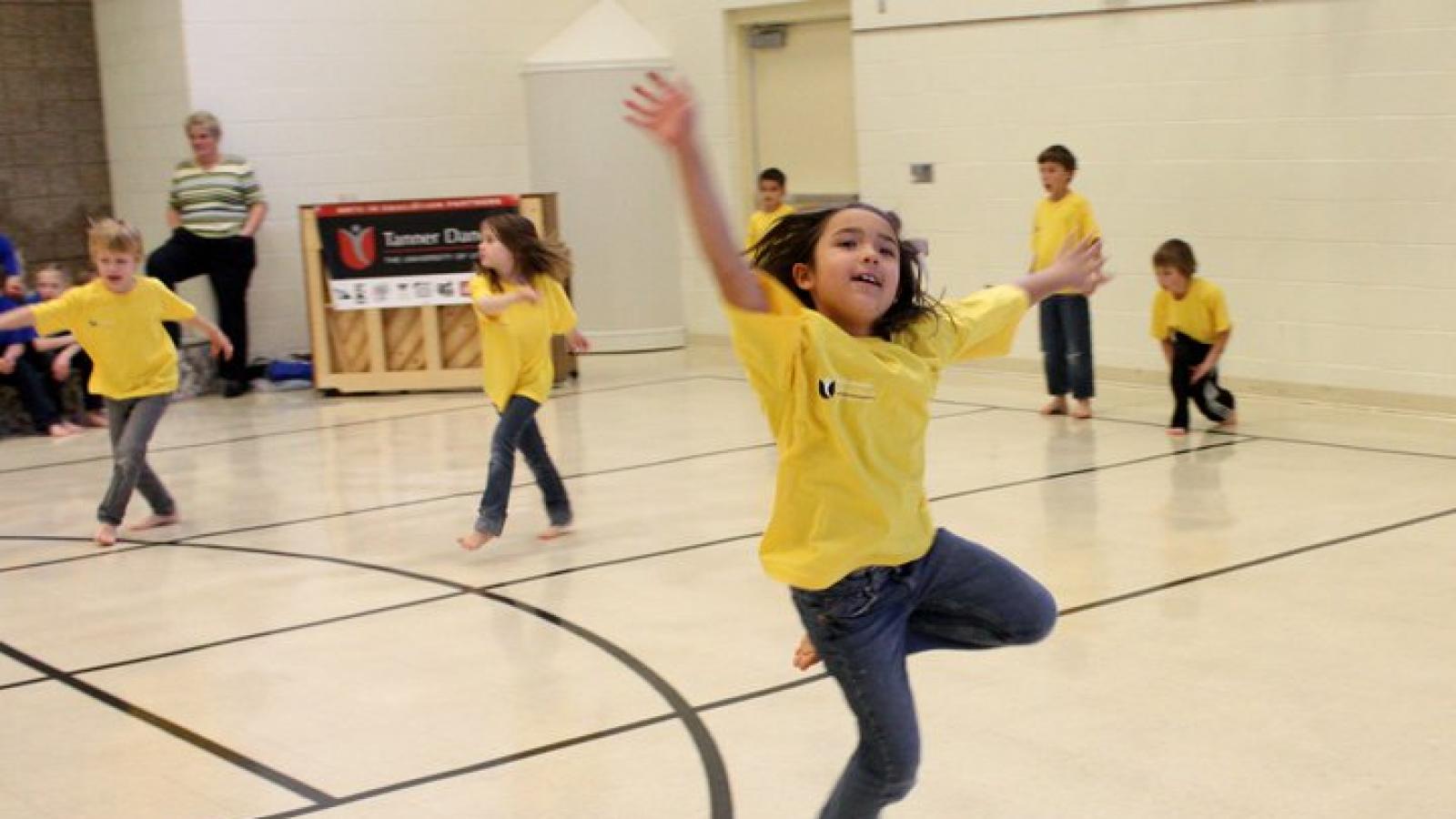In Utah, Dance and Learning Move Side by Side

Children from Utah's Bonneville Elementary School participate in Tanner Dance's Side-by-Side program. Photo courtesy of Tanner Dance
What does evaporation look like? How might condensation move through space? Would it be with soft tippy-toes and wiggling fingers, or with broad sweeps of one’s arms and legs? Using movement to explore concepts like the water cycle, the Side-by-Side Dance Residency Program from Tanner Dance at the University of Utah adds an entirely new dimension to elementary school curricula, bringing academic topics to life while introducing children to the concepts of movement and the joy of dance.
“The learning is so rich and deep,” said Mary Ann Lee, artistic director of Tanner Dance. “When you go through all the avenues of the child—mind, body, spirit, and heart—you get full learning. If students have moved the water cycle, then they understand precipitation, evaporation, and condensation. They really get it.”
Launched in 1994, the Side-by-Side program has its roots in the National Endowment for the Arts’ Artists-in-Schools program, which counted both Tanner Dance’s founder, Virginia Tanner, and Lee among the master artists who served as artists-in-residence at schools across the country. Today, the Side-by-Side program—a longtime NEA grantee—serves schools throughout Utah during yearlong, semester, or trimester residencies, as well as through remote residences for schools in rural areas. With NEA support, remote residencies allow rural classrooms to livestream with a classroom where a teaching artist is physically present, allowing two sets of children in two different locations to simultaneously learn and interact.
Working with classroom teachers, Side-by-Side dance specialists develop lessons that Lee said use “academic curriculum ideas as springboards for movement.” As children learn about everything from photosynthesis to the animals of the savannah, they are also learning dance concepts and building flexibility, endurance, and strength. This integration promotes a different sort of muscle memory: Lee said teachers have told her of students quietly getting up during a test and moving through a lesson until they arrive at the answer.
“These are children,” said Lee. “They move. They're experiential. Even from when they're tiny, that's how they learn. We can't just take that out of them and we can't take the joy out of them.”
But the program is about far more than using dance as a memory aid. It’s about stimulating the imagination, promoting creative expression, and encouraging children to explore the full capabilities of their bodies. Through the program, “every single child has the opportunity to be honored, to have his or her ideas expressed, to have another channel into him or her that will open doors into other areas,” said Lee. It’s a process that Lee said builds self-confidence among children and creates a community through dance as children find new ways to celebrate their classmates beyond academics. “It changes the climate of the school,” Lee said.
Side-by-Side can be particularly transformative for children learning English, as well as for those with special needs—two populations that the program actively seeks to reach. For children with language barriers, dance offers a non-verbal form of communication, suddenly providing a way to connect with their peers and demonstrate their capacity to teachers.
For a child with cognitive or physical differences, Side-by-Side can be just as profound. “You give them the sense of beauty in their body,” said Lee. “You give them the sense of freedom. You give them the opportunity to choose. These kids do not get to choose very many things in their lives, but having an opportunity to choose what color streamer they want or how they do the ‘hello dance’ as they come into the classroom—those are magnificent for their hearts and their spirits.”
Parents and school staff are invited to see the impact of the program during “informances,” which blend dance performance with demonstrated knowledge of the topic at hand. Lee said these presentations give the community an opportunity to realize that “this is incredibly valuable. I see these kids focusing. I see them totally engaged. I see them dancing their hearts out. I see them joyously moving. I see them understanding this curriculum area.”
Such community buy-in is critical, Lee said, to ensuring that arts education remains a priority for the school. “If we are good at what we're doing, and helping to build advocacy, then we also leave behind the hunger for the art form to continue in one way or another.” By generating this hunger, Lee believes that children—every part of them—will continue to flourish, from healthy bodies that love to move to imaginations that bloom with creativity. “A child is not just a brain that learns to read and do math,” said Lee. “There have to be alternative ways of getting to children.”




